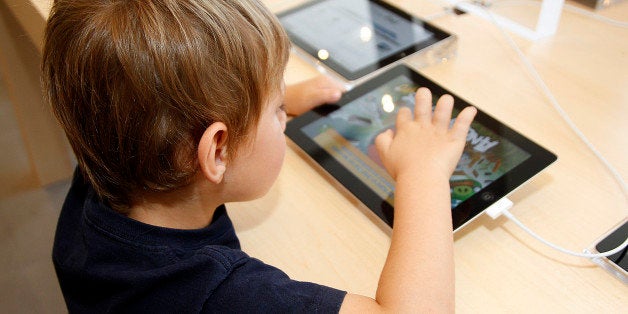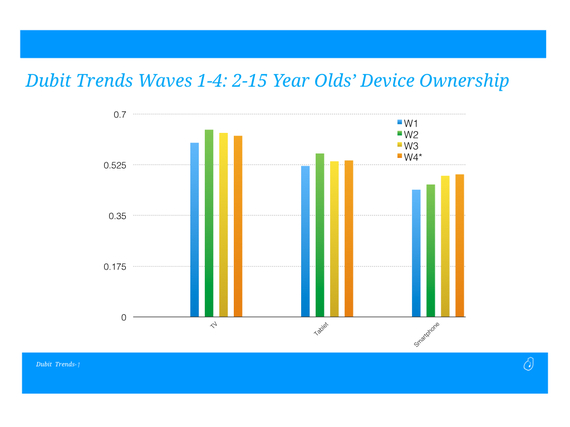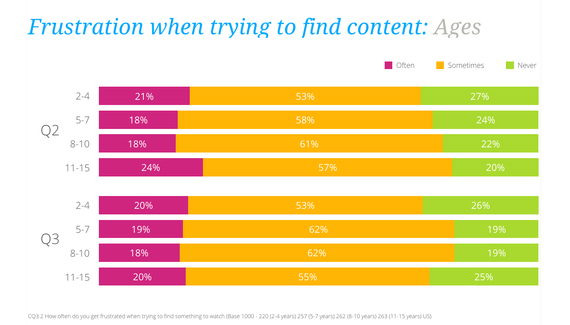
What would happen if a farmer didn't have to worry about extreme weather for five years? Could she concentrate on innovative growing techniques or new crops? If a race driver knew the specs for his car formula were fixed for a half-decade, could he focus on optimizing calibration and technique behind the wheel?
So, what would happen if children's media makers felt confident that kids' technology base wouldn't be upended for a prolonged period? Suppose we could stop looking over our shoulders, worrying that we're developing for devices destined for obsolescence before we're finished. Ideally, we'd then be able to focus on creative content, and audience-friendly delivery platforms that support discovery and sharing.
That's the situation we're envisioning for the foreseeable future. Here's the logic:
Quarter by quarter, Dubit Trends is seeing growing concentration among young people on the smartphone and tablet. The TV in the corner is still getting the plurality of children's time and attention, but does-everything device use is rising inexorably.
The smartphone was the fastest device in history to achieve US market saturation (now nearly 80%), and global adoption has been equally record-breaking. The tablet was almost as fast to 50% penetration in the US. The earliest smartphones debuted in 2002 (and the iPhone in 2007); for all intents and purposes, the tablet boom began with the iPad launch in 2010.
Sales of both smartphones and tablets slowed in the last year, as the market reached capacity. Telcos have an interest in selling you new smartphones to keep your service, and processing speed advances drive some new purchases. There's less incentive to replace tablets, and old devices often stay active when parents pass them down to their children.
We don't see anything on the horizon poised for such speedy, radical market disruption and dominance. If that's correct, it would offer the children's media industry five years or more of creative liberation. We'd know where to find our audiences, and have a more stable foundation for research into what they want, when and how.
(Sure, there will be innovation. Smart TV sets will breathe new life into the big screen, keeping families in the living room. Virtual and augmented reality will emerge in 2016, with high-grade consumer headsets and, more important for kids, massive deployment of inexpensive Cardboard viewers. We'll see many new toys and products incorporating artificial intelligence; the New York Times calls Amazon's Echo the "next great gadget" for its responsive, smart functionality. But, none of these will displace smartphones and tablets among kids. In fact, they're more likely to connect with and enhance them.)
How should content creators take advantage of this calm period? Dubit sees a couple clear areas of need.
In our Trends surveys, one challenge rises above all others: discovery. Worldwide (US, UK, Turkey, Brazil, Australia and Malaysia), more than 60% of children of all ages tell us they often or sometimes get frustrated trying to find content they want. Given their surfeit of media options, we don't think they mean appealing content doesn't exist; they're saying it's buried in an overwhelming mountain of choices.
The second area demanding attention is stickiness. When use is focused on all-in-one devices, everything - play, reading, creativity, learning, communication, social - is just a "home" button away. Once a child does find your content, how do you keep them engaged?
During a technology stasis, there's time to evolve thoughtful platforms for specific devices, to aid both discovery and retention. We already see many companies exploring aggregation of their IP into "content on demand" services for mobile, that keep children within their brand's space by aggregating video, apps and games.
Artificial intelligence may become the most valuable tool for all children's media content creators, in addressing both challenges.
Smart search and recommendation will help young people navigate the sea of content, especially when combined with improving interfaces like voice recognition. Young kids, in particular, are much better able to speak their preferences than try to type them.
Once they've made a selection, AI can be applied to enhance user experience and engagement with apps, games and on-demand aggregations, not to mention toys and products.
A third technique to undertake during a period of calm is a review for seamless simplicity from start to finish. How do you ensure that your service is clear, friendly and instantaneous; that options are narrowed to avoid paralysis of choice; and that you're helping and encouraging users to stick around or come back soon, made "top of mind" for them by a great experience.
I remember a comedian in the 1990s saying she'd buy a CD player when they could promise her nothing new would come along to make it obsolete. Surely, she's been through many generations of tech since.
Maybe now's the moment where we can stop and breathe, though, at least for a few years. Use it well, and you can move your young audiences from frustration to empowerment and satisfaction.

